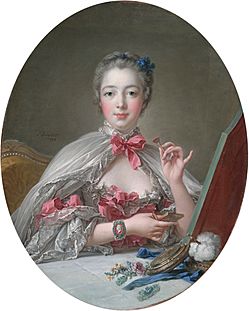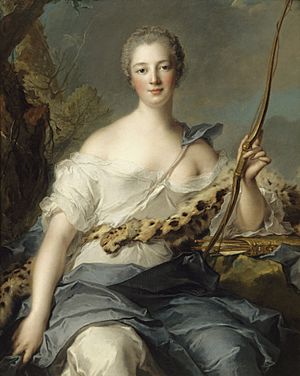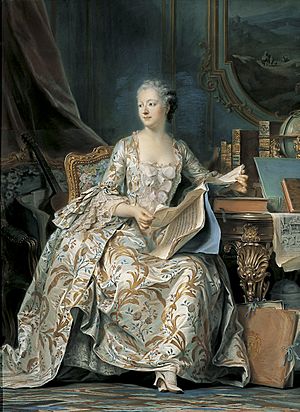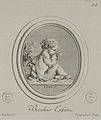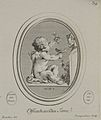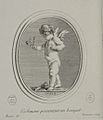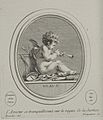Madame de Pompadour facts for kids
Quick facts for kids
Madame de Pompadour
|
|
|---|---|
| Marquise of Pompadour | |
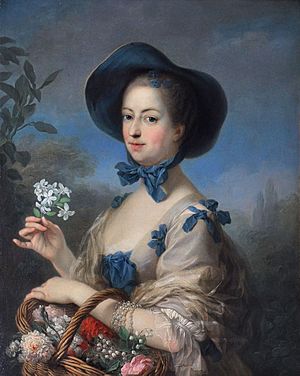
Portrait by Charles-André van Loo, ca.1755
|
|
| Coat of arms |  |
| Full name |
Jeanne Antoinette Poisson
|
| Born | 29 December 1721 Paris, Kingdom of France |
| Died | 15 April 1764 (aged 42) Paris, Kingdom of France |
| Buried | Couvent des Capucines |
| Spouse(s) |
Charles Guillaume le Normant d'Étiolles
(m. 1741) |
| Issue |
|
| Father | François Poisson |
| Mother | Madeleine de La Motte |
| Signature | |
| Occupation | Chief mistress of Louis XV |
Jeanne Antoinette Poisson, Marquise de Pompadour (/ˈpɒmpədʊər/, French: [pɔ̃paduʁ] ; 29 December 1721 – 15 April 1764), commonly known as Madame de Pompadour, was a member of the French court. She was the official chief mistress of King Louis XV from 1745 to 1751, and remained influential as court favourite until her death.
Pompadour took charge of the king's schedule and was a valued aide and advisor, despite her frail health and many political enemies. She secured titles of nobility for herself and her relatives, and built a network of clients and supporters. She was particularly careful not to alienate the Queen, Marie Leszczyńska. On 8 February 1756, the Marquise de Pompadour was named as the thirteenth lady-in-waiting to the queen, a position considered the most prestigious at the court, which accorded her with honors.
Pompadour was a major patron of architecture and decorative arts, especially porcelain. She was a patron of the philosophes of the Enlightenment, including Voltaire.
Hostile critics at the time generally tarred her as a malevolent political influence, but historians are more favorable, emphasizing her successes as a patron of the arts and a champion of French pride. Art historian Melissa Hyde argues that the critics of Pompadour were driven by fears over the overturning of social and gender hierarchies that Pompadour's power and influence, as a woman who was not born into the aristocracy, represented.
Contents
Early life
Jeanne Antoinette Poisson was born on 29 December 1721 in Paris to François Poisson and his wife Madeleine de La Motte. It is suspected that her biological father was either the rich financier Jean Pâris de Monmartel or the tax collector (fermier général) Charles François Paul Le Normant de Tournehem. Le Normant de Tournehem became her legal guardian when François Poisson was forced to leave the country in 1725 after a scandal over a series of unpaid debts; such crime at that time was punishable by death, however, he was cleared eight years later and allowed to return to France.
At age 5 Jeanne Antoinette was sent to receive the finest quality education of the day in an Ursuline convent in Poissy, where she gained admiration for her wit and charm. Due to poor health, thought to be whooping cough, Jeanne Antoinette returned home in January 1730 at age 9. During this time her mother took her to a fortuneteller, Madame de Lebon, who predicted that the girl would one day reign over the heart of a king. Henceforth she became known as Reinette, meaning "little queen", and was groomed to become the mistress of Louis XV. Tournehem arranged for Jeanne Antoinette to receive a private education at home with the best teachers at the time. From there on she was taught dancing, drawing, painting, engraving, theatre, the arts and the ability to memorize entire plays. It may have been this sponsoring of Jeanne Antoinette's education in particular that sparked rumors of his paternity to Poisson.
Marriage
At the age of nineteen, Jeanne Antoinette was married to Charles Guillaume Le Normant d'Étiolles, the nephew of her guardian Charles Le Normant de Tournehem, who initiated the match and the large financial incentives that came with it. On 15 December 1740, Tournehem made his nephew his sole heir, disinheriting all his other nephews and nieces: the children of his brother and sister. These included the estate at Étiolles, a wedding gift from her guardian, which was situated on the edge of the royal hunting ground of the forest of Sénart. Once married, Le Normant d'Étiolles fell passionately in love with his wife, while she addressed that she would never leave him – except for the King. The couple had a son who died in infancy and a daughter, Alexandrine Le Normant d'Étiolles born in 1744, who died at the age of nine.
Attendance of salons
As a married woman, Jeanne Antoinette could frequent celebrated salons in Paris, such as those hosted by Mesdames de Tencin, Geoffrin, du Deffand and others. Within these salons she crossed paths with principal figures of the Enlightenment, including Voltaire, Charles Pinot Duclos, Montesquieu, Helvétius, and Bernard de Fontenelle. Additionally, Jeanne Antoinette created her own salon at Étiolles, which was attended by many of the cultural elite, among them were Crébillon fils, Montesquieu, the Cardinal de Bernis, and Voltaire. Within these circles she learned the fine art of conversation and developed the sharp wit for which she would later become known at Versailles.
Meeting the King
Due to her involvement in Paris salons as well as her grace and beauty, Louis XV had heard the name of Jeanne Antoinette mentioned at court as early as 1742. In 1744, Jeanne Antoinette sought to catch the eye of the King while he led the hunt in the forest of Sénart. Because she occupied an estate near this location she was permitted to follow the royal party at a distance. However, wanting to attract the King's notice, Jeanne Antoinette drove directly in front of the King's path, once in a pink phaeton, wearing a blue dress, and once in a blue phaeton, wearing a pink dress. The King sent a gift of venison to her. Though the King's current mistress Maria Anne de Mailly, named Madame de Châteauroux, had warned off Jeanne Antoinette, the position became vacant on 8 December 1744 when Châteauroux died. On 24 February 1745, Jeanne Antoinette received a formal invitation to attend the masked ball held on February 25 at the Palace of Versailles to celebrate the marriage of the Dauphin Louis of France to Infanta Maria Teresa of Spain. It was at this ball that the King, disguised along with seven courtiers as a yew tree, publicly declared his affection for Jeanne Antoinette. Before all of court and the royal family, Louis unmasked himself before Jeanne Antoinette, who was dressed as Diana the Huntress in reference to their encounter in the forest of Sénart.
Introduction to court
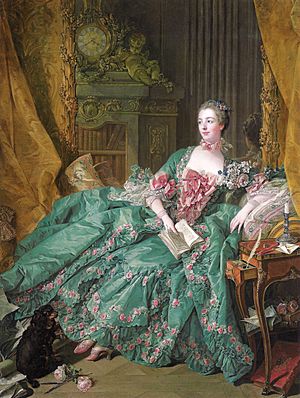
By March, she was the King's mistress, installed at Versailles in an apartment directly above his. On 7 May, the official separation between her and her husband was pronounced. To be presented at court, she required a title. The King purchased the marquisate of Pompadour on 24 June and gave the estate, with title and coat-of-arms, to Jeanne Antoinette, making her a Marquise. On 14 September 1745, Madame de Pompadour made her formal entry before the King, presented by the King's cousin, the Princess of Conti. Determined to make her place at court secure, Jeanne Antoinette immediately attempted to forge a good relationship with the royal family. After the Queen engaged Pompadour in a conversation by enquiring after a mutual acquaintance, Madame de Saissac, Pompadour responded in delight, swearing her respect and loyalty to Marie Leszczyńska. The Queen in return favored Jeanne Antoinette instead of the King's other mistresses. Pompadour quickly mastered the highly mannered court etiquette. However, her mother died on Christmas Day of the same year, and did not live to see her daughter's achievement of becoming the undisputed royal mistress.
Royal mistress
Through her position as court favourite, Pompadour wielded considerable power and influence; she was elevated on 12 October 1752 to duchess and in 1756 to lady-in-waiting to the Queen, the most noble rank possible for a woman at court. Pompadour effectively played the role of prime minister, becoming responsible for appointing advancements, favors and dismissals, and contributing in domestic and foreign politics.
In 1755, she was approached by Wenzel Anton, Prince of Kaunitz-Rietberg, a prominent Austrian diplomat, asking her to intervene in the negotiations which led to the Treaty of Versailles. This was the beginning of the Diplomatic Revolution, which saw France allied to their former enemy Austria.
Under these changed alliances, the European powers entered the Seven Years' War, which saw France, Austria and Russia pitted against Britain and Prussia. France suffered a defeat at the hands of the Prussians in the Battle of Rossbach in 1757, and eventually lost the American colonies to the British. After Rossbach, Madame de Pompadour is alleged to have comforted the king with the now-famous: "au reste, après nous, le Déluge" ("Besides, after us, the Deluge"). France emerged from the war diminished and virtually bankrupt.
Madame de Pompadour persisted in her support of these policies, and when Cardinal de Bernis failed her, she brought Choiseul into office and supported and guided him in all his plans: the Pacte de Famille, the suppression of the Jesuits and the Treaty of Paris (1763). Britain's victories in the war had allowed it to surpass France as the leading colonial power — something which was commonly blamed on Pompadour.
Pompadour protected the Physiocrates school (its leader was Quesnay, her own doctor) which paved the way for Adam Smith's theories. She also defended the Encyclopédie edited by Denis Diderot and Jean le Rond d'Alembert against those, among them the Archbishop of Paris Christophe de Beaumont, who sought to have it suppressed. In Diderot's first novel, Les bijoux indiscrets (The Indiscreet Jewels), the characters of Mangogul and Mirzoza are allegories of Louis XV and Pompadour respectively. Diderot portrayed Pompadour in a flattering light, most likely to ensure her support for Encyclopedie. Pompadour had a copy of Les bijoux indiscrets in her library, which may explain why the crown did not pursue Diderot for such an indiscretion against the king.
The marquise had many enemies among the royal courtiers who felt it a disgrace that the king would thus compromise himself with a commoner. She was very sensitive to the unending libels called poissonnades, analogous to mazarinade against Cardinal Mazarin and a pun on her family name, Poisson, which means "fish" in French. Only with great reluctance did Louis take punitive action against her known enemies, such as Louis François Armand du Plessis, duc de Richelieu.
Friend of the King
Madame de Pompadour was able to wield such influence at court due to the invaluable role she played as a friend and confidante of the King. In opposition to previous mistresses of Louis XV, Pompadour made herself invaluable to the King by becoming the only person whom Louis trusted and who could be counted on to tell him the truth. Pompadour was an indispensable comfort to Louis who was prone to melancholy and boredom. She alone was able to captivate and amuse him, and would entertain Louis with elegant private parties and operas sometimes even with his wife, Queen Marie Leszczyńska in attendance since she would also invite her with the help of the King, afternoons of hunting, and journeying among their various real estate holdings.
Around 1750 Madame de Pompadour's role as friend of the King became her solitary role.
The consecration and the château de Saint-Ouen
Built in the second half of the 17th century, the château de Saint-Ouen, (near Paris, in the Seine-Saint-Denis department), has belonged to the prestigious dukes of Gesvres until its destruction in 1821, to built the actual château for the comtesse du Cayla. After the sale of her château de Crécy, unexpectedly, the marquise de Pompadour did not purchase Saint-Ouen but benefited from the usufruct of this residence from 1759 until her death in 1764.
The plan of the château, originally designed by Antoine Lepautre, was a classical U-shape and consisted of a long façade with two wings prolonging the main body, facing the river Seine on the garden side.
Saint-Ouen's originality resided in its interior distribution: the main body consisted of a succession of three "salons à l'italienne", whose decoration was entirely modified by the Slodtz family in the 1750s for the Gesvres family. In French architecture, a "salon à l'italienne" is a room filling all the height of a building: a memorable example is the Grand salon at Vaux-le-Vicomte.
In addition to this layout, as soon as Mme de Pompadour acquired the estate, a vast project of reorganisation of the entire buildings (including stables and dependences) was planned, costing more than 500.000 livres. In the absence of the original plans, a restitution of the ground floor has been proposed. It seems that the architect who supervised this reorganisation was Ange-Jacques Gabriel, who, at that time, directed all the renovation and building works of the different residences of Mme de Pompadour. Using the central "salon à l'italienne" as a pivot, an appartement was created for the King as a counterpart to that of the henceforth Duchesse de Pompadour, making the prestigious château de Saint-Ouen into a reflection of her own status - a symbol of her social and political achievements.
Patron and participant in the arts
Madame de Pompadour was an influential patron of the arts who played a central role in making Paris the perceived capital of taste and culture in Europe. She attained this influence through the appointment of her guardian Charles François Paul Le Normant de Tournehem, and later her brother, Abel Poisson in the post of Directeur Général des Bâtiments, which controlled government policy and expenditures for the arts. She championed French pride by constructing and later outright buying a porcelain factory at Sèvres in 1759, which became one of the most famous porcelain manufacturers in Europe, and which provided skilled jobs for the region. Numerous sculptors and portrait painters were patronized by Pompadour, among them the court artist Jean-Marc Nattier, in the 1750s François Boucher, Jean-Baptiste Réveillon and François-Hubert Drouais. She patronized Jacques Guay, the gemstone engraver, who taught her to engrave in onyx, jasper and other semi-precious stones.
Pompadour greatly influenced and stimulated innovation in what is known as the "Rococo" style in the fine and decorative arts: for example, through her patronage of the artists like Boucher and the constant refurnishing of the fifteen residences she held with Louis. Like Pompadour, this style was critiqued by some as a pernicious "feminine" influence, despite the fact that it was embraced by many men as well as women (Hyde, 456–458). However it is also widely recognised that Madame de Pompadour engaged with prominent artists as a way to capture the attention of the king whilst cultivating her public image. The oil sketch of Pompadour's lost portrait by Boucher sits in the Starhemberg room at Waddesdon Manor built by Baron Ferdinand de Rothschild, surrounded by Sèvres porcelain, another industry that she greatly influenced and innovated through personal dissemination across an international network of her own clientele.
In addition to supporting the arts as a patron, Pompadour also participated in them more directly. Besides being one of the few 18th-century practitioners of gem engraving, she was an acclaimed stage actress in plays staged at her private theaters at Versailles and Bellevue (Hyde, 463–4). Melissa Hyde has suggested that some of the artworks made under Pompadour's purview by other hands, notably the 1758 portrait by Boucher of Mme de Pompadour at Her Toilette, can be fruitfully viewed as collaborations with Pompadour.
Madame de Pompadour is considered an amateur printmaker who made print engravings with the help of Boucher. She had engraving equipment, to create the prints of works by Boucher and Guay, brought within her personal apartments in Versailles
Her political mind can also be attributed to her great book collection. She collected influential books such as the History of the Stuarts, printed in 1760 with her own printing press which can be determined through the stamp markings of her arms located on the cover. Baron Ferdinand de Rothschild, an avid 19th-century collector in London and Waddesdon Manor, collected a number of her books, including this previously mentioned book and a copy of her published catalogue of books from 1764, which lists her entire collection.
Artwork
Madame de Pompadour created 52 engraved prints, of drawings by Boucher, after gemstone engravings by Guay. Her collection of work, in book form, is called "Suite d'Estampes Gravées Par Madame la Marquise de Pompadour d'Apres les Pierres Gravées de Guay, Graveur du Roy" which translates to in English as "Series of Prints engraved by Madame la Marquise de Pompadour after the engraved stones of Guay, engraver of the King".
The personal portfolio of Madame de Pompadour was found in the Walters Art Museum manuscript room by art historian Susan Wager.
Some art historians argue whether or not she should be considered a collaborator with the artists under her patronage, since there is no documentation of how much Pompadour might have contributed to the works; whose idea, and whose composition, will remain a mystery.
- List of museums and libraries with a copy of her portfolio
- Walters Art Museum, Baltimore
- Met Museum, New York
- British Museum, London
- Boston Museum of Fine Arts
- Bibliothèque de l'Arsenal, Paris
- Rothschild collection, Louvre
- Bibliothèque de Troyes
Death

Louis XV remained devoted to Pompadour until her death from tuberculosis in 1764 at the age of forty-two. Louis nursed her through her illness. Even her enemies admired her courage during the final painful weeks. Voltaire wrote: "I am very sad at the death of Madame de Pompadour. I was indebted to her and I mourn her out of gratitude. It seems absurd that while an ancient pen-pusher, hardly able to walk, should still be alive, a beautiful woman, in the midst of a splendid career, should die at the age of forty-two." Many of her enemies were, however, greatly relieved. Looking at the rain during the departure of his mistress's coffin from Versailles, the devastated king reportedly said: "La marquise n'aura pas de beau temps pour son voyage." ("The marquise will not have good weather for her journey".) She was buried at the Couvent des Capucines in Paris.
Portrayals in film and television
Madame de Pompadour has been depicted on screen in film and television on many occasions, beginning in 1924 with Paulette Duval opposite Rudolph Valentino in Monsieur Beaucaire. A biopic came out three years later called Madame Pompadour directed by Herbert Wilcox, in which she was played by Dorothy Gish. Other actresses to have played her include:
- Anny Ahlers (Madame Pompadour, 1931)
- Doris Kenyon (Voltaire, 1933)
- Jeanne Boitel (Remontons les Champs-Élysées, 1938)
- Hillary Brooke (Monsieur Beaucaire, 1946)
- Geneviève Page (Fanfan la Tulipe, 1952)
- Micheline Presle (Royal Affairs in Versailles, 1954)
- Monique Lepage (Le Courrier du roy, 1958)
- Elfie Mayerhofer (Madame Pompadour, 1960)
- Noëmi Nadelmann (Madame Pompadour, 1996)
- Katja Flint (Il giovane Casanova, 2002)
- Hélène de Fougerolles (Fanfan la Tulipe, 2003)
- Sophia Myles (as an adult) and Jessica Atkins (as a child) in "The Girl in the Fireplace", an episode of the BBC science fiction series Doctor Who, 2006.
- Hélène de Fougerolles (Jeanne Poisson, marquise de Pompadour, TV 2006)
- Bojana Novakovic (Casanova, 2015)
See also
 In Spanish: Madame de Pompadour para niños
In Spanish: Madame de Pompadour para niños


